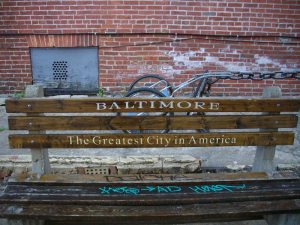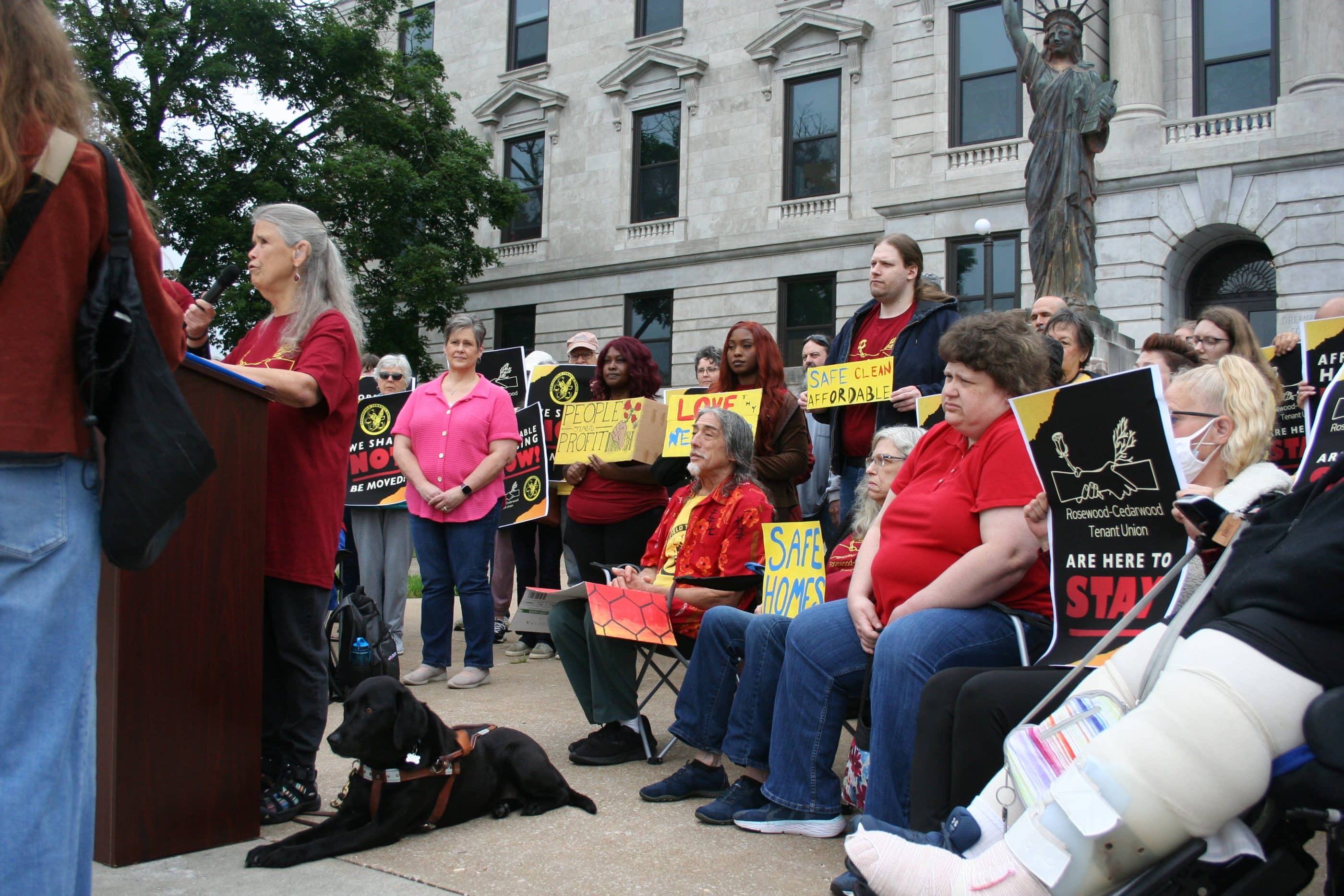
Photo by Flickr user shootingsawk, CC BY-NC-ND 2.0
It’s time for some straight talk about rising property values. Yes, they help amass equity for homeowners, provide opportunities for developers, and generate revenue for localities. But they also raise rents, pushing out low-income renters; keep the unhoused, unhoused; and push fixed-income homeowners into fiscal precarity. If community development is about the entire human community, and not just real estate, we must grapple with this tension. Higher property values and equitable development are not an easy marriage.
Parks, new housing, calm traffic, quality schools, presence of grocers and businesses, increased streetlights, a sense of community safety, blight reduction, and neighborhood cohesion all push property values higher. So does almost every aspect of positive community development. Remedying the racial imbalance in wealth creation through homeownership relies, to a great extent, on this property value appreciation. But if pushing values up for existing homeowners requires pushing out low-income homeowners and renters of limited means, and creates fewer affordable housing options for the unhoused, we have a quandary.
Baltimore distinguished itself in the post-World War II period as a city of homeowners. Almost two-thirds of its residents owned in the early 1950s, before government-subsidized and racially covenanted suburbs facilitated white flight, and the dynamics of increased global competition encouraged manufacturers to exit. Only 48 percent of the city’s residents own today, in a city that is about 62 percent African American.
Since that postwar peak, the value of homes in many neighborhoods has dropped.
Neighborhoods on both the west and east sides of the city that were redlined by the U.S. Home Owners Loan Corporation in a 1937 map are now, in the city’s 2017 Housing Market Typology map, marked as areas with sales values about 80 to 90 percent below average in Baltimore.
But on the east side, real estate developers transformed warehouses, flophouses, and wharves into luxury housing, thereby pushing up the property values of adjacent neighborhoods that had previously been classified as “stressed.”
It is in those stressed neighborhoods that SHARE Baltimore’s network of community land trusts operates, and where we see firsthand the mixed blessing of high property values.
Low property values in the stressed neighborhoods—on both the east and west sides of Baltimore—discouraged property sales by homeowners for decades, facilitated homeowner-to-rental conversion, and contributed to a vacant housing stock in Baltimore that ranges from 16,000 to 47,000 depending on who’s counting. But, as property values on the east side now rise, vacant houses in stressed neighborhoods adjacent to prime neighborhoods are now becoming attractive to market-rate minded developers. As our CLTs seek to acquire these same vacant houses to rehab into permanently affordable homes, the competition with market-rate developers has pushed up our acquisition costs.
While most would assume that homeowners in these stressed neighborhoods on the east side would welcome the competition between developers and CLTs because it ultimately pushes up their own property values and increases home equity, it is not so simple.
Low- and fixed-income homeowners, particularly the elderly, face higher property taxes and increased attention from housing code enforcement, along with the usual maintenance and repair challenges that come with homeownership. “Circuit-breaker” tax policies and other tax credits do cushion property tax appreciation, and there is a hodgepodge of home repair programs, but the relief is a fraction of the cost. Some homeowners fail to keep up, falling into tax lien auctions where they can be foreclosed upon by speculators. For others who are pestered daily with offers from house buyers paying in cash, selling becomes an economic escape. Whichever way it happens, homeowners who never wanted to leave are pushed out.
Renters on the east side face their own precarity. As landlords near gentrifying areas raise rents, or convert rental units to ownership, low-income tenants become housing cost burdened or subject to serial displacements. Years ago, at a Baltimore Housing Roundtable “Speak Out” that helped establish our current SHARE Baltimore CLT network, tenants described their plight. One resident said they had moved 21 times in 29 years. Since the pandemic’s onset in 2020, the median rent in Baltimore City has increased by 19 percent. A 2020 report by the U.S. Government Accountability Office indicated that there is a 9 percent increase in the estimated homelessness rate for every $100 increase in median rent.
So again, what is our goal in community development? Is it about improving neighborhoods to the extent that all residents, both homeowners and renters, are able to stay put, and for those on the street to find affordable rentals? If that’s the case, property value appreciation keeps getting in the way.
We certainly can talk about harm reduction measures such as inclusionary housing, eviction prevention, and the expansion of rental subsidies, as well as the creation of deeply affordable housing, but we know these efforts are being outpaced by overwhelming demand. But we also know that most of the private lenders, foundations, and local governments from whom we draw our capital are more interested in community development through real estate value appreciation than in the people who are displaced by the market’s invisible hand.
Of course, this has a certain logic. Lenders need real estate collateral that covers their risk. City officials in Baltimore have frequently expressed the hope to our CLTs that city subsidies will leverage private capital investment, and we already know that real estate appreciation means city property tax revenue will increase. But both petty and professional speculators circle neighborhoods like vultures, hungry for profit opportunities. We can say that “development without displacement” is what we all want, but profit-seeking institutions—and local governments often act like such in this context—have only one aim and value. Our common ground with them is temporary and, sadly, based primarily on the increase of real estate values. And worse, we know significant private capital investment can spark gentrification once incentivized by the government and by the private lenders that we’ve invited to neighborhoods.
Claire Dunning, who recently wrote Nonprofit Neighborhoods: An Urban History of Inequality and the American State, observed that nonprofits in the 1970s and 1980s traded the “radical possibilities of community development for the financing necessary to make the physical development possible. Intermediaries tried to help CDCs bridge the seemingly impossible position of contributing to urban growth and preventing it from getting too far out of residents’ reach by privatizing, financializing, and abstracting urban redevelopment. The shift built on the state apparatus of government grantmaking from the 1960s, but in its increasing embrace of the market as a site of resources and organizational models in the 1970s, accelerated a neoliberal governing regime in American cities.”
We’ve seen that acceleration come to fruition. So, what do we do?
First and foremost, let’s acknowledge and speak about the tensions we see and often perpetuate.
Our community development efforts, if successful, will indeed raise property values, thereby putting certain groups at risk of displacement and exclusion. Even we in the CLT community, who like to think we have the answer to development without displacement, must acknowledge this possibility. In Northeast Baltimore, our successful rehab of 15 vacant houses in a “stressed” neighborhood has already pushed sale prices up, according to anecdotal and real estate reports. Will this have an impact on rents? What impact will this have on fixed-income homeowners? Will the currently unhoused find affordable housing in this neighborhood? Let’s ask this aloud, to ourselves and to our financial partners.
Let’s also acknowledge and speak about the tensions between housing as a wealth-building asset and de-commodified housing that enables the poorest to be housed. I think we all can tell the difference between a family seeking a firm financial footing in a society with few, if any, safety nets, and a real estate speculator. And I think we all recognize that housing for the poor has always been unprofitable in the marketplace and thereby requires significant government aid that assures security of tenure to renters and housing for the currently unhoused.
And let’s fight real estate speculation and the opaque legal entities that are its foot soldiers. Divestment from real estate investment by pension funds controlled by government or private anchor institutions is a prudent first step.
Community development is complicated and not for the faint of heart. We operate within racialized investment footprints that have created both vacant and luxury housing, both Whole Foods and food deserts, both private and public schools, and both safe and insecure communities. For those of us laboring within these dynamics who are interested in a new more equitable community development that values homeownership equity, rental affordability, and freedom from involuntary displacement, let us find our way through the current maze with honest talk to one another, neighborhood leaders, government officials, lenders, and foundations about the equitable conundrum that increasing property values create. And then let us all work together to figure out how communities can develop in a way that meets the fundamental need of all for housing.
Editor’s Note: This article has been updated to add in a sentence that was left out due to a technical error.





It’s not even a dirty little secret. By removing the semantic error of “property values” for land value we see that the artificial injections of cash by private or institutional equity bids up the price of land quickly and far beyond the capacity of the community to keep up. The solutions provided scant: clumsy government interventions and underfunded CLTs. What’s needed is a financial instrument to make land too expensive to hold for speculation. That instrument is a land value tax (or land value return). Making the cost of holding land too expensive will drive down the selling price of land. The revenue gained from collecting taxable land values can go to affordable housing trust funds and even acquiring land that local and state governments often hold.